Global-e Orders in Shopify
Whenever a checkout is triggered and a shopper clicks the ‘pay’ button, Global-e creates a matching cart on the Global-e side. Global-e processes the payment.
Once the payment is authorized, an order is created automatically in Shopify.
Global-e creates an order in parallel on the Global-e side using Shopify’s API.
Downstream Data Flow from Shopify
At Checkout, Global-e begins calculating the international prices, duties & taxes, and shipping methods.
Orders are created by Shopify and per Shopify’s multi-currency concepts, in two currencies:
Presentment money: what international customers see on the storefront, cart, checkout, and transactional emails.
Shop money: The main currency of your Shopify store and the currency used for reporting and analytics.
Note
Shop money is what should be mapped downstream by your order management and accounting systems.
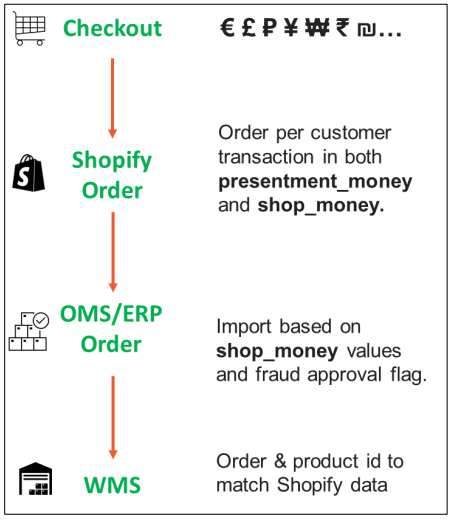
Fraud check
Global-e performs a fraud check for international orders.
Initial order creation has the payment status PENDING (financial_status property).
Important: Merchants should not submit any orders for fulfilment at this time and wait on Global-e to complete the fraud check.
When the fraud check is completed, the payment status is updated to PAID. Orders may now be submitted for fulfilment.
WMS and operations
For Global-e to generate international shipping labels & customs documents, the warehouse pick-pack process must reference Shopify’s order name and SKU.
Alternatively, the Shopify order number and/or Shopify EAN/barcode/variant ID may be used instead.
Reach out to Global-e as additional configuration may be needed in those cases.
When a shopper places the order on the checkout page:
Shopify creates an order.
Shopify Order Status:
PaidGlobal-e creates a matching order on the Global-e Merchant Portal.
Tag:
Globale::PendingGlobal-e verifies the payment and customer fraud status.
Order Status:
PaidTag:
Globale:: ApprovedThis tag indicates that you can fulfil the Global-e order.
If for any reason, the order or the payment is not authorized, Global-e can cancel the order, in which case, the Shopify status shows: Cancelled.
End-to-End Order Flow Interfaces
A general illustration of an order flow with Shopify to OMS to WMS and Global-e in the picture.

Outbound
Order creation: created in Shopify with initial payment status 'PENDING’ and order tag ‘Globale::Pending’.
Fraud check: upon successful fraud check (asynchronous process), the payment status goes to ‘PAID’ and the order tag is replaced with ‘Globale::Approved’.
Export to OMS/WMS qualified orders: with ‘PAID’ status or tagged with Globale::Approved.
Pick and pack: used by the warehouse to identify orders via the Shopify order name/number and sku/upc.
Label generation: Global-e interface provides a final mile carrier label and a tracking number.
End-of-day manifest: signals to Global-e that the order is ready to be dispatched and generates an end-of-day document.
Fulfilment update to Shopify: in most scenarios, this event or the tracking number itself is provided by Globale. It is also expected for Shopify to send the shipment confirmation email when its fulfilment is created.
Global-e Order Information
To view the Global-e order information:
In the Shopify Admin, go to Orders.
The Orders screen opens, showing the list of orders (Global-e and non-Global-e Orders).
Click a Global-e Order.
The Global-e order details screen opens.

The Global-e details screen provides the following information:
The
Global-e Order ID(under Additional Details). The Global-e Order ID starts withGEand ends with the merchant's country code. In this example, the Global-e Order ID is GE175560204GB.The price that the shopper paid in local (customer) currency. In this example, the price is €205.00
The duties and taxes in merchant and shopper currencies
Customer Information
When fulfilling the order, this screen shows both tracking Information and a tracking link. In addition, the order shipment information shows the tracking number.
Global-e order tag:
Globale::Approved.Order Status. See Global-e Orders in Shopify for more information on statuses.
Shopify Order Data Examples
This Shopify store belongs to a US merchant and the storefront currency is in USD.
Below are two different order scenarios in which a single product is purchased:
Duties & taxes are paid by the customer – the checkout explicitly displays D&T-related line items.
Duties & taxes are inclusive/baked into product prices – the merchant subsidizes the D&T costs.
Scenario 1: Duties & taxes paid by the customer
Market: Israel.
The customer pays separately for all the D&T-related costs including the customs clearance fee (CCF) represented here in the “Additional Fee” field.
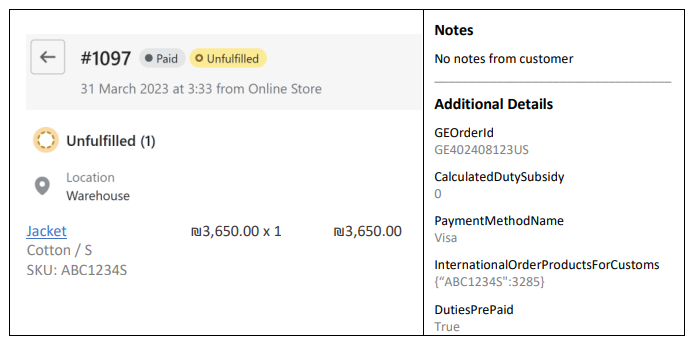
Note
The Additional Details section is for information and is not required for data consumption. CalculatedDutySubsidy represents the total order level subsidy in storefront currency. In this example, there is no subsidy for this order, hence the $0.
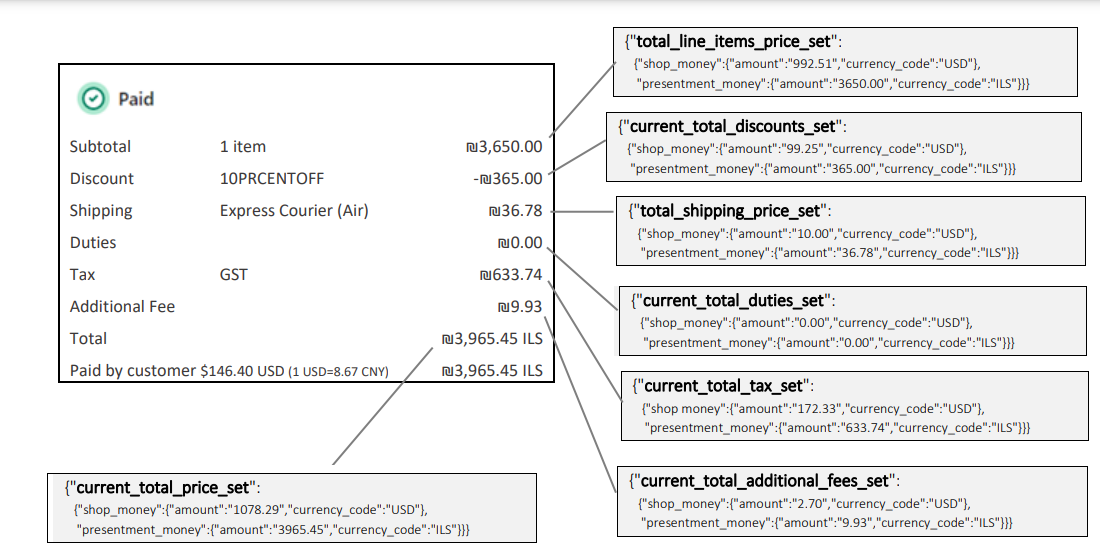
Important
The Additional Fee set is a new Shopify data line available in Shopify’s API release version 2023-04. See https://shopify.dev/docs/api/admin-rest/2023-04/resources/order for reference.
Scenario 2: Duties & taxes are included in the product price
Market: United Kingdom.
Duties, taxes, and customs clearance fees are all-inclusive in the £500.00 product price in this example.
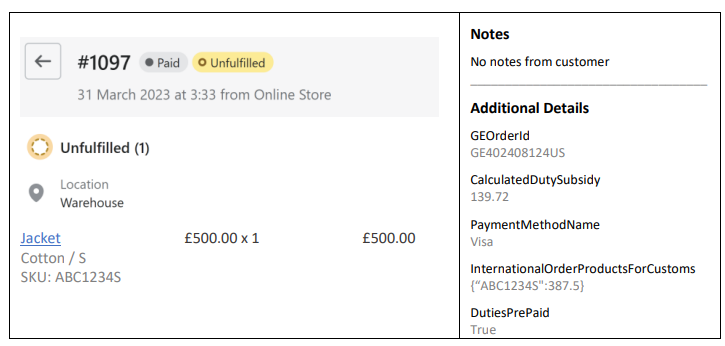
CalculatedDutySubsidy 139.72 USD includes duties, VAT, and CCF.
Note: the D&T line items do not appear in the order details at all.
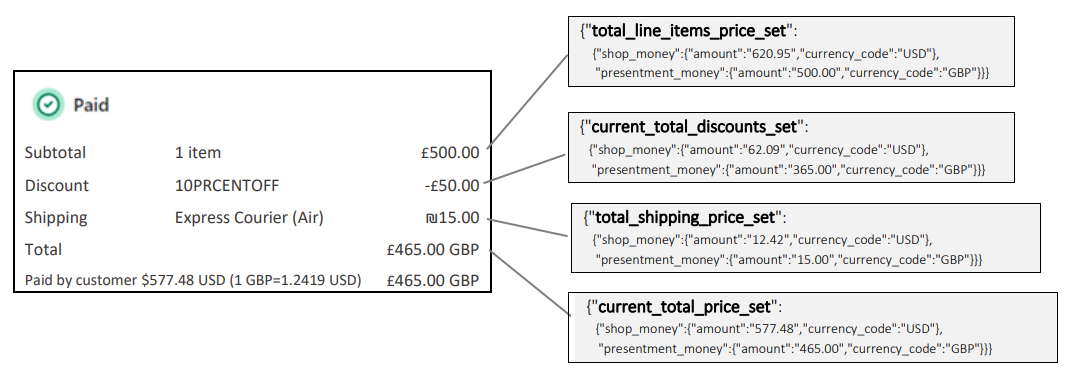
Conclusion
Duty, tax, and customs clearance fees (CCF) are all part of the overall duties and taxes calculation.
When a customer’s checkout displays duty & tax-related fees, these costs appear as order line items.
Any subsidized costs, whether both duties and taxes or just duty or just taxes – appear in the note attributes
CalculatedDutySubsidyfield.
Shopify Order JSON example
A full example of an order JSON file can be downloaded here:Shopify Order JSON example.
Accounting Perspective
From a Shopify view, orders are created per customer as a B2C transaction with Global-e. From an accounting perspective, orders should be treated as domestic B2B orders booked against a Global-e account.
You may book any order line items to calculate gross revenue while bearing in mind that in most scenarios Global-e is responsible for handling remittance and filing local VAT and other taxes.
For estimated net revenue, you can subtract the CalculatedDutySubsidy field. For actual revenue, refer to the Global-e financial reconciliation report.
Global-e to Shopify Order Updates
Global-e updates Shopify when a customer places a new order, or when an order is fulfilled, cancelled, or refunded.
Free Shipping on Orders
Select one of the following methods to create orders with a zero shipping fee:
Method 1: Update the Shopify template
Navigate to the product-template.liquid file in your Shopify theme.
within the {% form 'product' ... %} block, insert the following code snippet adjusting the internal logic as needed for your implementation:
{% assign property='someValue' %} <input class="input" type="hidden" name="properties[{{ property }}" value='{{ property }}' />Add the product to the cart to submit the form.
The property is now available on cart.js.
Method 2: Update the cart via API
Insert or update the cart with one of the following APIs:
Insert
curl -X POST \
https://{store_name}.myshopify.com/api/2024-10/graphql.json \
-H 'Content-Type: application/json' \
-H 'X-Shopify-Storefront-Access-Token: {storefront_access_token}' \
-d '{
"query": "mutation cartLinesAdd($cartId: ID!, $lines: [CartLineInput!]!) {
cartLinesAdd(cartId: $cartId, lines: $lines) {
cart {
# Cart fields
}
userErrors {
field
message
}
warnings {
# CartWarning fields
}
}
}",
"variables": {
"cartId": "gid://shopify/Cart/123",
"lines": [
{
"attributes": [
{
"key": "<your-key>",
"value": "<your-value>"
}
],
"merchandiseId": "gid://shopify/ProductVariant/123",
"quantity": 1,
"sellingPlanId": "gid://shopify/SellingPlan/123"
}
]
}
}'
Update
curl -X POST \
https://{store_name}.myshopify.com/api/2024-10/graphql.json \
-H 'Content-Type: application/json' \
-H 'X-Shopify-Storefront-Access-Token: {storefront_access_token}' \
-d '{
"query": "mutation cartLinesUpdate($cartId: ID!, $lines: [CartLineUpdateInput!]!) {
cartLinesUpdate(cartId: $cartId, lines: $lines) {
cart {
# Cart fields
}
userErrors {
field
message
}
warnings {
# CartWarning fields
}
}
}",
"variables": {
"cartId": "gid://shopify/Cart/123",
"lines": [
{
"attributes": [
{
"key": "<your-key>",
"value": "<your-value>"
}
],
"id": "gid://shopify/CartLine/111",
"merchandiseId": "gid://shopify/ProductVariant/123",
"quantity": 1,
"sellingPlanId": "gid://shopify/SellingPlan/123"
}
]
}
}'Refund
You can use the Shopify Platform or the Global-e Merchant portal to create order refunds.
Important information for Merchants who charge customers for prepaid return labels on the Global-e Returns portal.
When a customer uses a prepaid shipping label, Global-e deducts the cost of shipping from their refund, resulting in a lower refund amount than indicated in the notification email. Since Shopify does not support paid returns, this can cause discrepancies in Shopify's recorded refund data and the notifications sent to customers. |
For example, if a customer returns a product that costs $95.30, with a $10 prepaid label generated on the Global‑e Returns portal, the notification email from Shopify indicates a refund amount of $95.30, when in reality the customer only receives $85.30. |
We recommend the following solutions: |
|
To refund an order:
Go to the Shopify Admin screen.
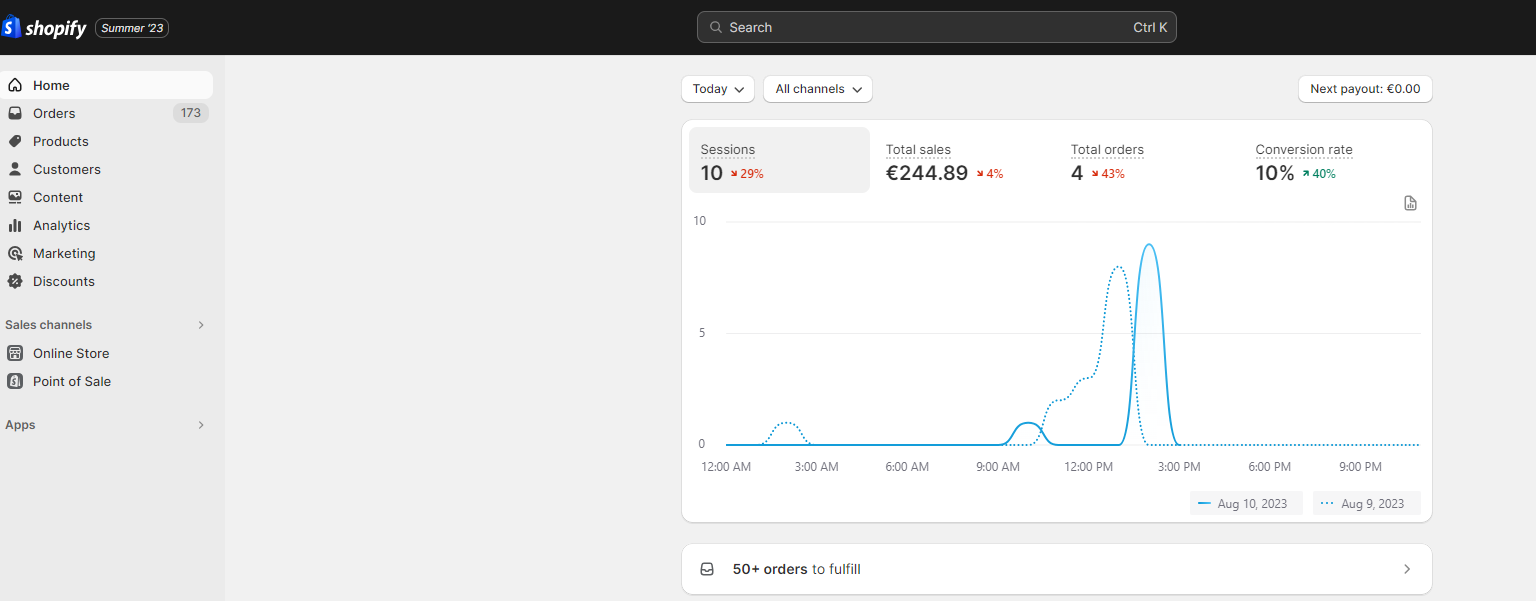
In the left navigation bar, click Orders.
The list of orders is displayed.

Select the order for which you want to perform a refund.
The order page opens.
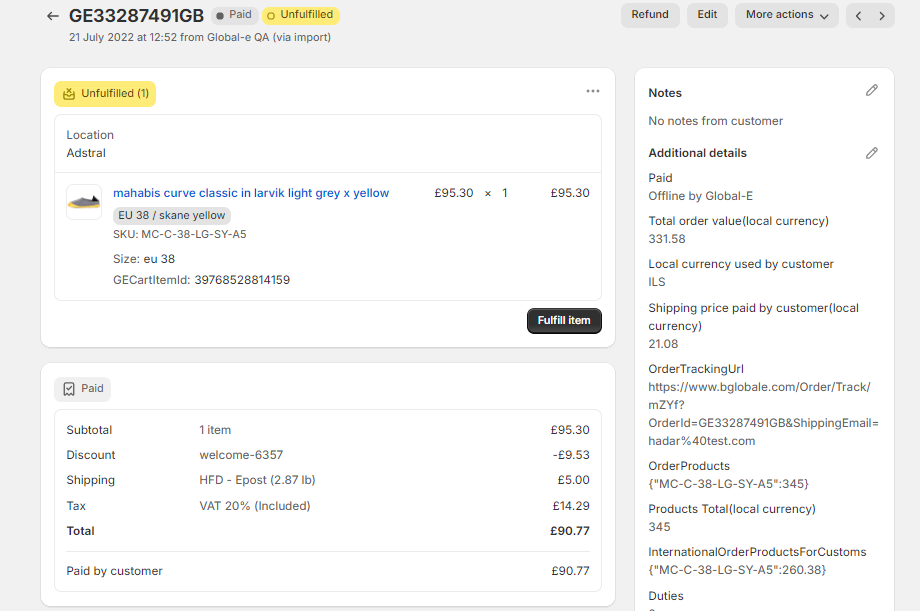
At the top-right of the page click Refund.
The Refund page opens.
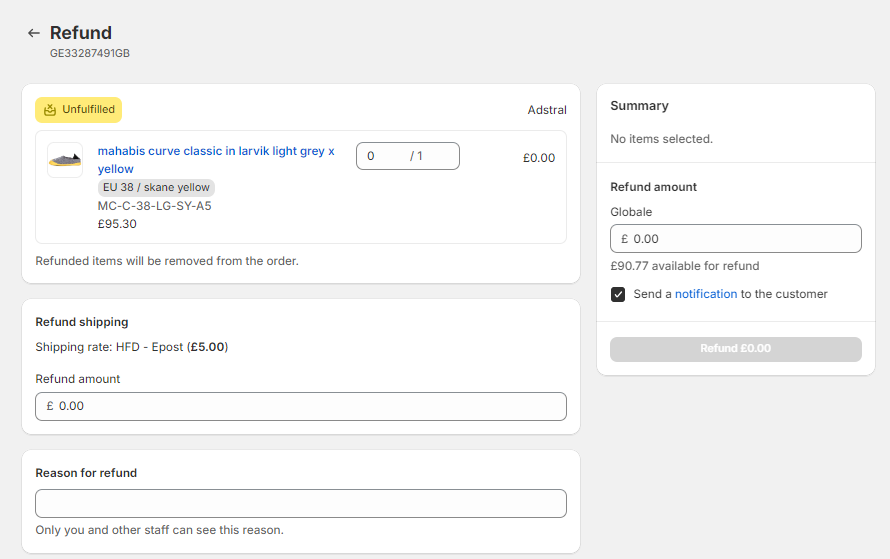
Enter the number of items that you want to refund.
If you don't want the item to be restocked, unselect the Restock Item option.
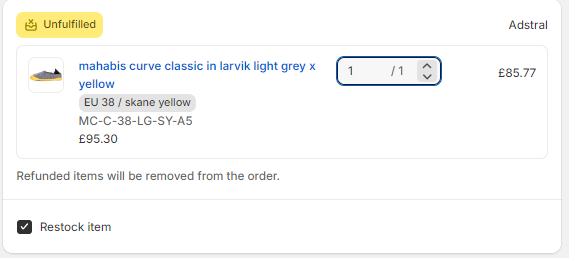
The Summary section displays the refund amount.

At the bottom of the page, you may include a reason for the refund.
Click Refund $(amount) to finalize the refund.
The order is refunded and a refund notification email is sent to the customer.
Cancel an Order
Orders are canceled directly through the Shopify Admin.
Important
An order that has been fulfilled or shipped cannot be canceled.
Canceled orders are not included in reports.
An automatic refund is issued, for the full order amount or the captured amount, for every order cancelation.
To cancel an order:
Go to the Shopify Admin screen.

In the left navigation bar, click Orders.
The list of orders is displayed.

Select the order that you want to cancel.
The order page opens.
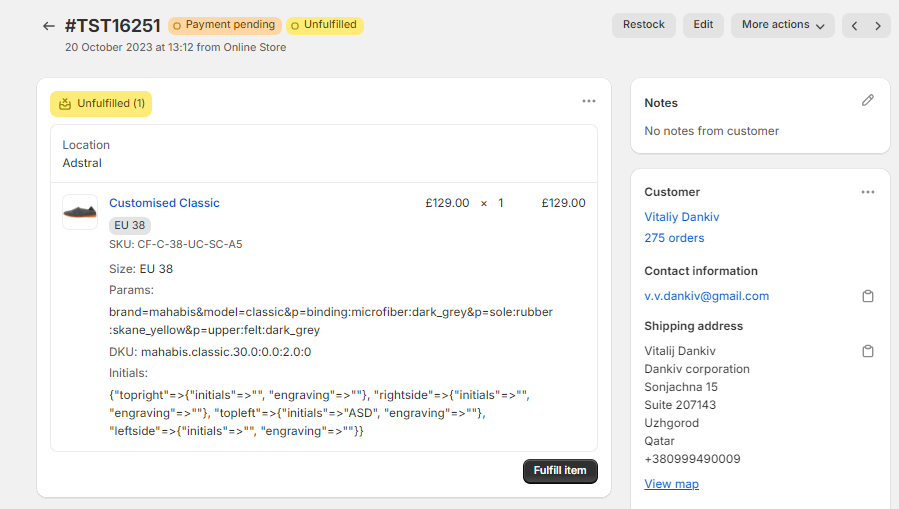
At the top-right, select More actions > Cancel Order.
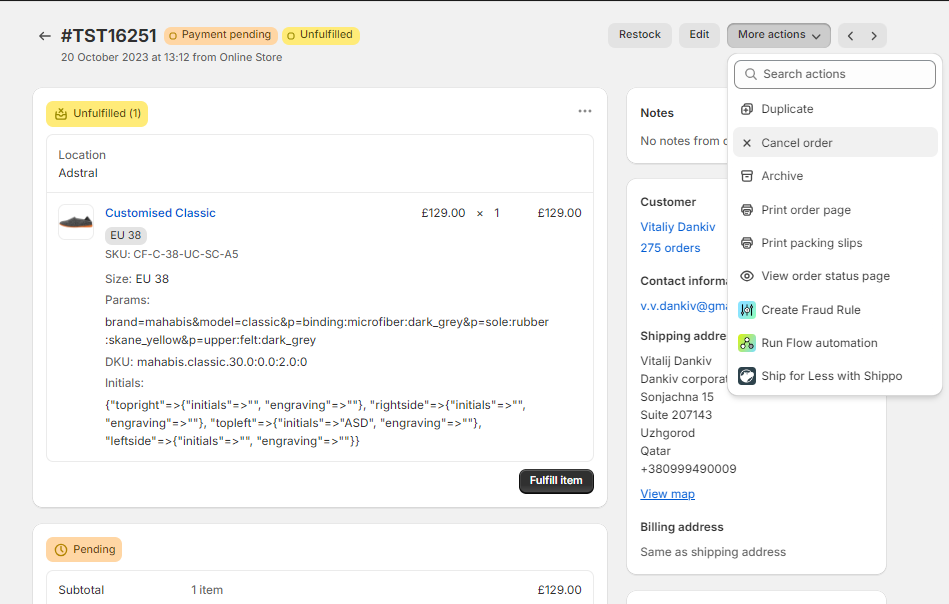
A confirmation window opens.
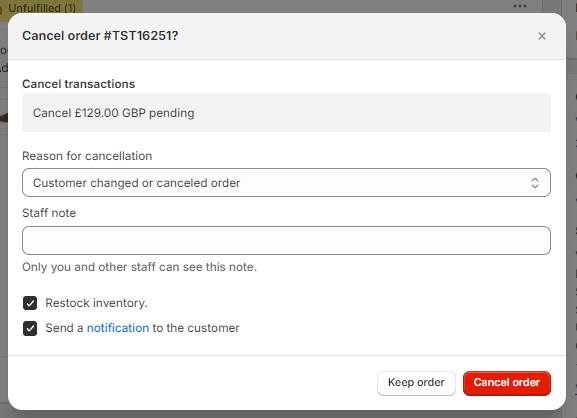
In the confirmation window, select a reason for the cancelation , and click Cancel Order.
If you do not wish to restock the inventory or have a notification sent to the customer, unselect those boxes.
The order is canceled and an email is automatically sent to the customer notifying them of the cancelation (unless you choose not to send a message).
Amend an Order
Shopify does not support amending orders; therefore, to make changes to an order you need to follow the same instructions as for processing a refund.
Note that although the Order Page menu does include an Edit option, you cannot use it to amend an order since the changes are not recognized by Global-e.
To amend an order, follow the instructions for a Refund.
Draft Orders
Overview
You can use the Draft Orders functionality to initiate an order directly from the Shopify admin:
To Place a Draft Order over the Phone or Email for a Customer
To Create Orders for Influencers (Without a Customer Payment)
To create Replacement Orders in Shopify. See Replacements in Shopify.
Place a Draft Order over the Phone or Email for a Customer
Place an order over the phone or by email on behalf of a customer and send them the payment link. Customers can also purchase products that are not yet available on the website
To create a Draft Order in Shopify:
You can create draft orders in either the Order or Drafts screens
From your Shopify admin, go to Orders.
Click Create order.

The Create order screen opens.

Enter the following information:
Step 1
Add products and quantities.
Step 2
Set one of the following:
Add a customer in the Customer section.
All the customer information is populated and the Market reflects the customer's country and currency.
- OR -
Change the destination country of the order:
Edit (
 ) the Market section.
) the Market section.In the pop-up, select the destination country for the order and click Change market.
Example
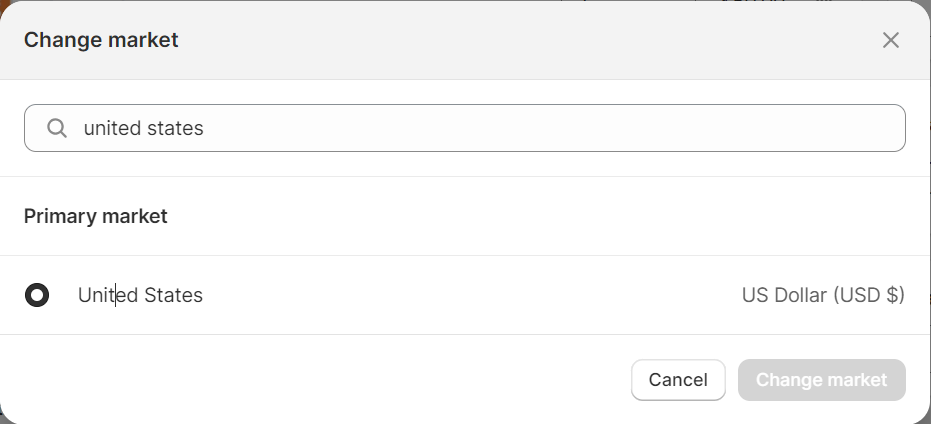
The Market reflects the selected destination country and currency.
Step 3
In the Payment section:
Click Add discount.
In the pop-up, select the Discount type: Amount (fixed Amount or percentage. .
Enter the Discount value and click Apply.
Example:
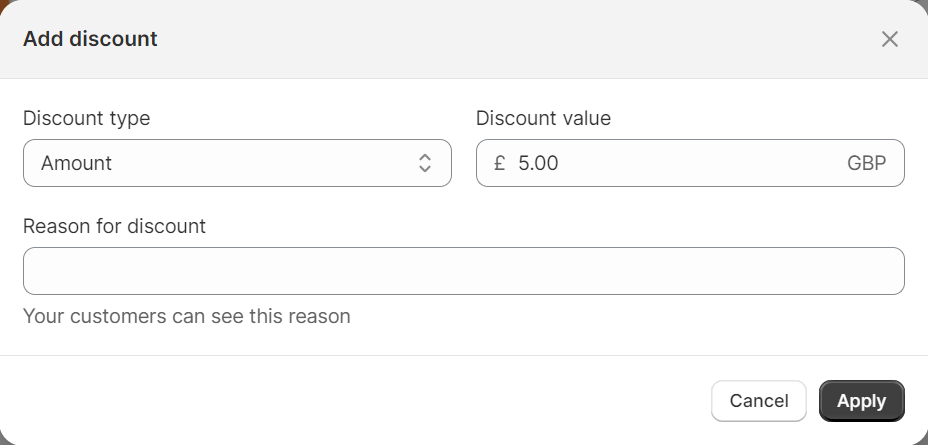
Click Estimated tax.
In the pop-up, select Charge taxes and click Apply.

Note that the customer cannot view the Duties and Taxes calculated during checkout (or know if there are taxes).
Step 4
Click Send invoice.
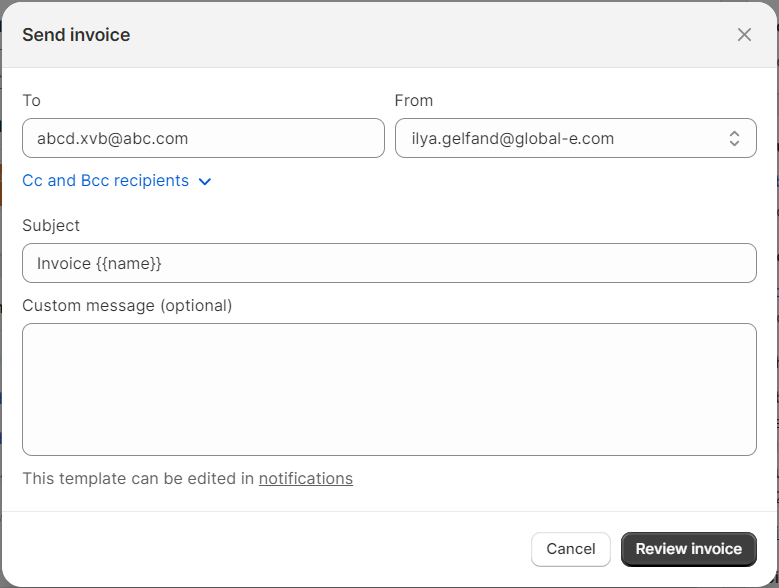
In the pop-up: if you added the Customer (in step 2), the customer's e-mail address is pre-populated. Otherwise, add the email address manually and enter the required information.
Click Review Invoice.
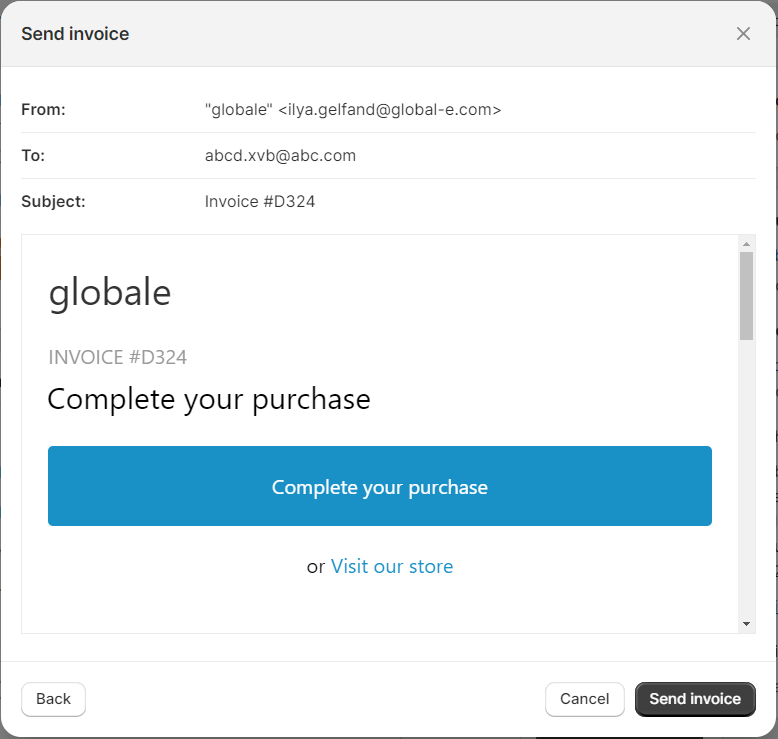
Click Send Invoice again.
Note
The customer cannot change the destination country on the checkout page as the currency and shipping options are calculated based on the selected market when creating the draft order.
Note that the following functionality is not supported:
Payment due later
Collect payment
Create Orders for Influencers (Without a Customer Payment)
Note: This feature must be enabled on your account before use. Please contact your Customer Success Manager to request activation.
Allow influencers to ship orders without Global-e or a customer payment.
Follow the steps below to set up influencer orders.
Create an order
On the top-left of the Shopify Admin page click Orders > Drafts.
The Drafts page opens.
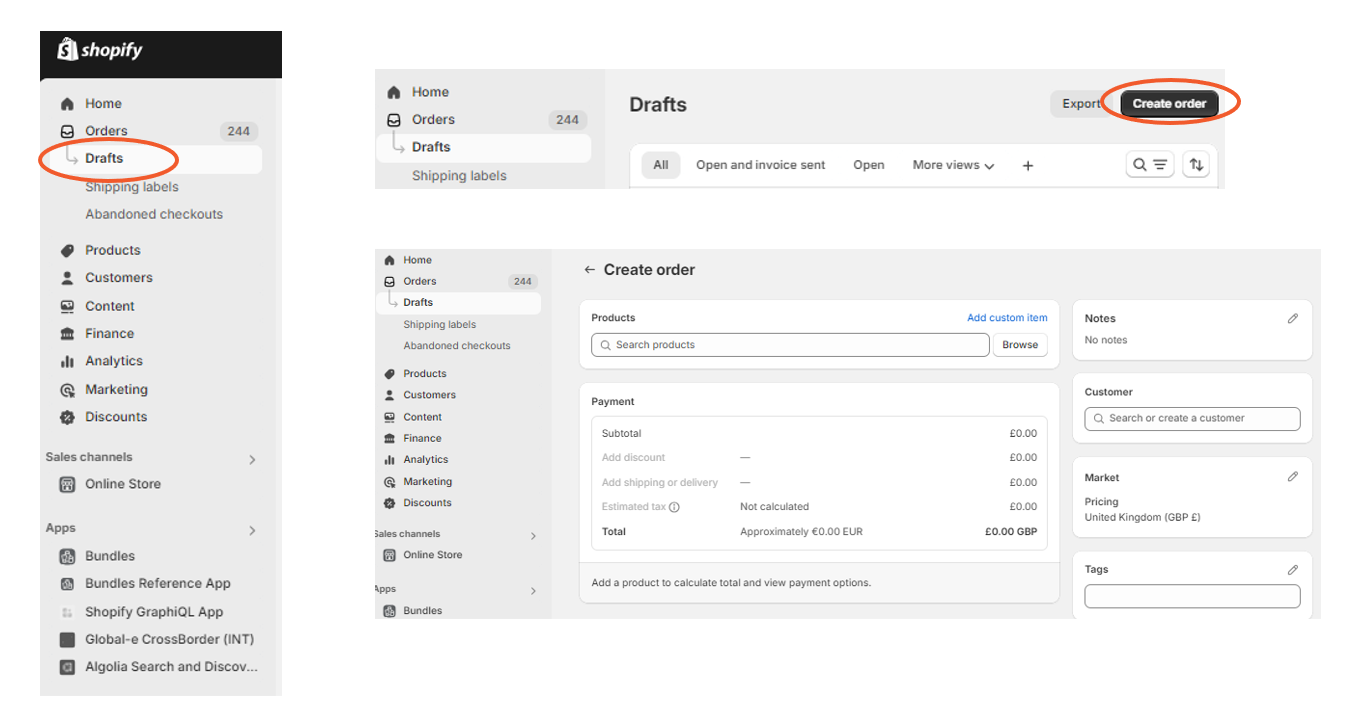
At the top-right click Create Order.
The Create Order page opens.
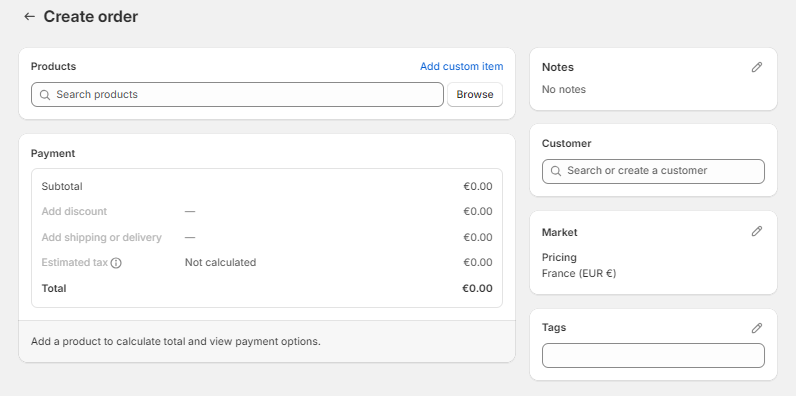
Add customer details
In the Customer section, click the search bar to view a list of your customers.
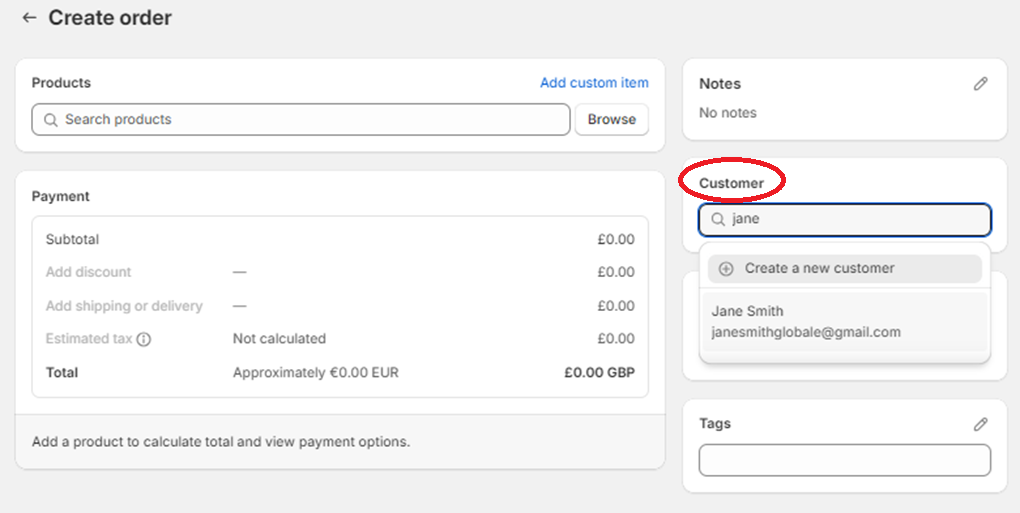
Select the name of the customer/influencer.

The customer details are displayed on the right.
Add products
Next to the Products search bar click Browse.

A window opens with a list of your products.

Select the desired product/s and click Add.

The products are added to the order.
Add the discount
In the Payment section click Add discount.
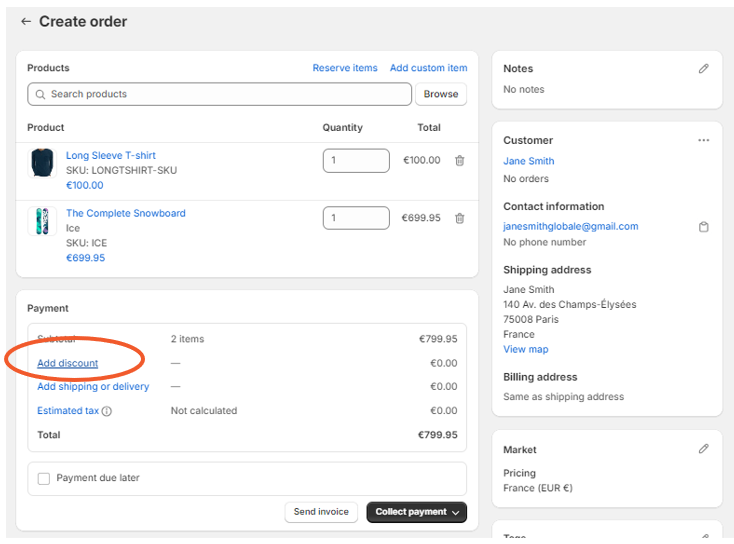
The Add Discount window opens displaying a list of available discount codes.
Select two discount codes, one for the order and the other for the shipping, and click Apply.
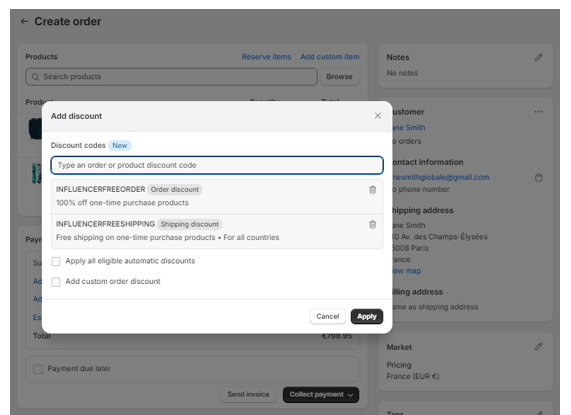
Both discount codes are applied to the order.

Add the shipping method
Click on Add Shipping or delivery.
The Shipping and delivery options window opens.
Click on the Shipping rates drop-down menu and select the desired shipping option.
Click Apply.
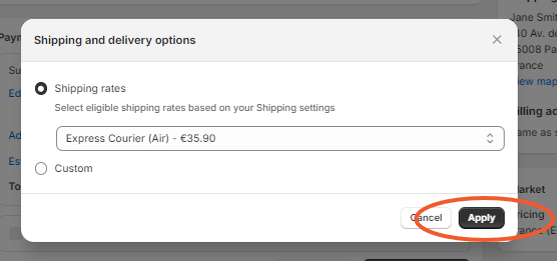
Create the order
At the bottom of the order screen click Collect Payment > Mark as Paid.
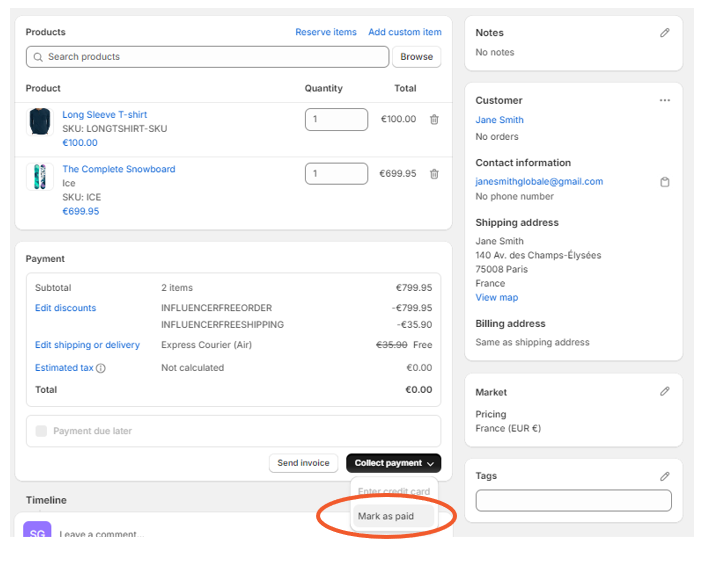
The Mark as Paid window opens, confirming the creation of a free order.

Click Create Order.
The order is finalized and can be viewed with the rest of your orders.

Shopify's Multi-Currency
Shopify's multi-currency feature enables customers to view prices in their local currency, make payments in their currency at checkout, and receive refunds in the same currency.
Shopify's multi-currency orders include both the storefront base currency (usually USD) and the customer currency (€, £, ¥, and more).
These currency values are stored as different fields in Shopify:
Shop_money – This field holds the storefront's base currency, which serves as the main currency for the Shopify store and is used for reporting and analytics. It is typically mapped downstream by order management systems (OMS) and accounting systems.
Presentment_money - This field stores the customer currency, visible to international customers in the storefront, cart, checkout, and transactional emails.
FX Conversion and Shopify API
Since Shopify’s multi-currency orders are created as the localisedlocalized customer currency (presentment_money), Shopify converts the values using FX conversion to get the shop_money in the Shopify Admin and APIs.
Shopify uses different rounding calculation functions for the shop_money value in the Transaction API and Order API:
Order API - This API retrieves the breakdown cost of individual line items in both shop_money and presentment_money. The total amount is calculated as the sum of these individual line items.
Transaction API - This API retrieves the total transacted amount in either shop_money or presentment_money.
FX Rounding Discrepancy
Introduction
This document explores the FX considerations related to Shopify's API and order total calculations.
When importing orders from Shopify into a third-party system, you can retrieve the order total:
Directly from Shopify’s Transaction API
- OR -
By re-calculating all order line items (via the Order API)
Mathematically, the order total from these two APIs would match without FX rounding. However, due to rounding, a decimal discrepancy may occur, as shown in the Rounding Discrepancy Example. This has been verified by Shopify as expected behaviour; it applies to all multi-currency orders and it is not specific to Global‑e.
For more info on Shopify multi-currency and API, see Shopify's Multi-Currency.
Rounding Discrepancy Example
A customer places an order in Canada that costs $395.50 CAD.
 |
The Order API provide the item cost, the shipping cost, the tax, and the sum of all these values.
The Transaction API provides the transacted amount from the customer.
 |
With the FX rate at 1.38726, there is a $0.01 difference between the sum of individual line item prices and the total transacted amount. This discrepancy arises due to rounding when comparing the order component FX conversions and the FX conversion of the total itself, leading to a normal and expected mismatch when rounded to two decimal places.
Presentment_money | Shop_money | Calculation | |
|---|---|---|---|
Order API | Line Item 1 = 350.00 CAD Taxes = 45.50 CAD Total price = 395.50 CAD | Line Item 1 = $252.30 USD Taxes = $ 32.80 USD Total price = $285.10 USD | 252.30 USD + 32.80 USD = 285.10 USD |
Transaction API | Total Amount = 395.50 CAD | Total Amount = $285.09 USD | 395.50 CAD / 1.38726 = 258.09 USD |
This behaviourbehavior applies to all Shopify multi-currency orders. Shopify has confirmed that this is not a bug and no API changes will be made.
Conclusion
No mandatory actions are needed. If you are using both the Transaction API and the Order API to get the order total, anticipate that the totals will not match exactly for Shopify multi-currency orders.
Replacements in Shopify
Overview
Global-e supports product replacements directly through the Shopify Admin.
Prerequisites
Update the Global-e Crossborder application.
Navigate to the Global-e CrossBorder App
INT (integration): https://admin.shopify.com/store/{{shopify-store}}/apps/global-e-crossborder-int
PROD (Production): https://admin.shopify.com/store/{{shopify-store}}/apps/global-e-crossborder
Go to Settings > Update Global-e Scopes.

Click Update Access Scope.
The Update page opens.
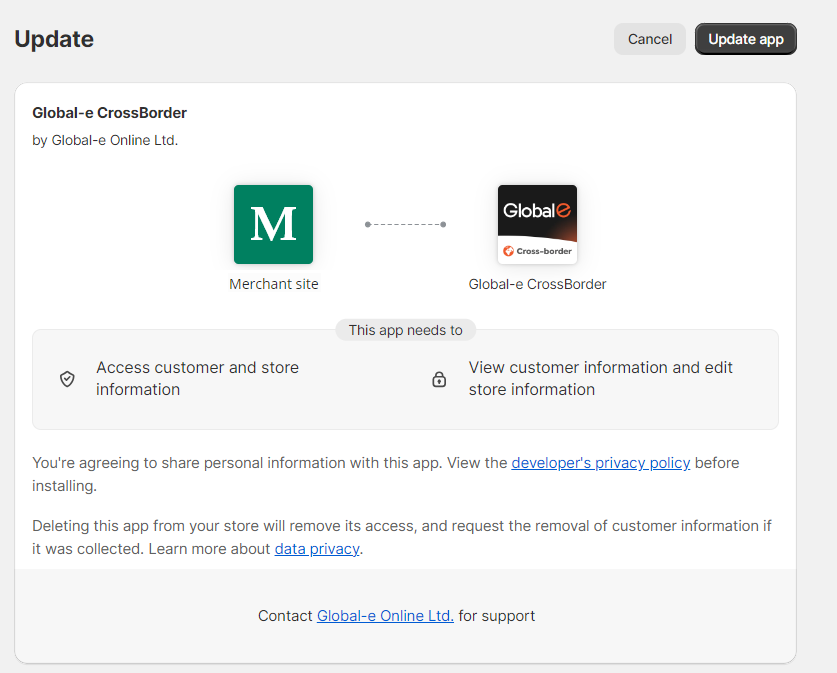
Click Update App.
Wait 10-15 minutes for the application to update before starting to create Shopify replacements.
A message under the Update Access Scope button confirms that the app has been successfully updated.

Note
Global‑e’s responsibility does not involve validating orders when creating replacement orders.
Performing a Replacement in Shopify
To perform a replacement in Shopify:
Go to the Shopify Admin screen.

In the left navigation bar, click Orders.

The list of orders is displayed. See step 3., below.
Select the order that you want to replace.

The original order opens.

At the top-right, select More actions > Start Global‑e Replacement.

An instruction page opens, explaining the process for replacing an order.
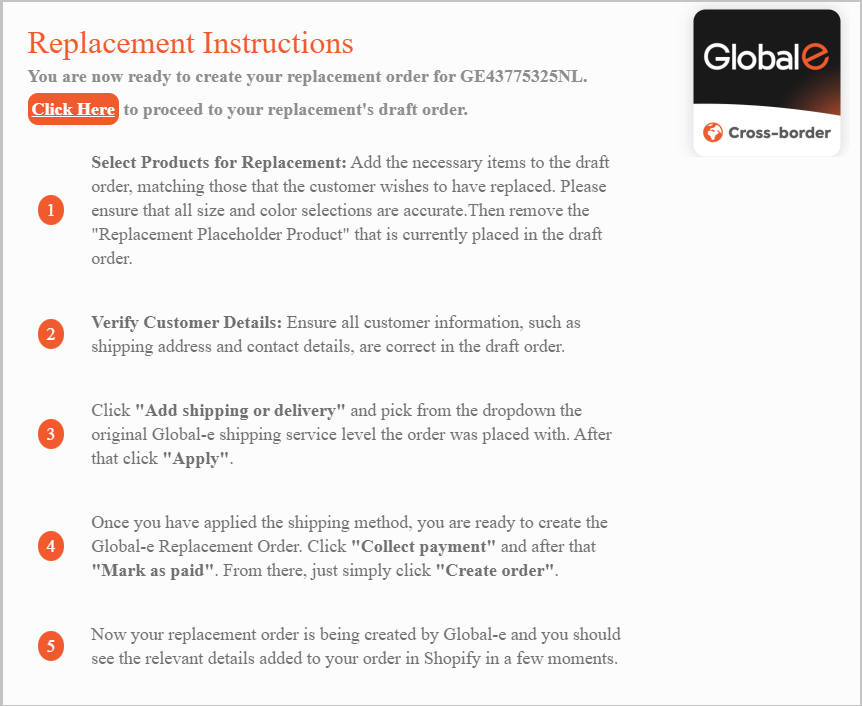
At the top of the Replacement Instructions page, select Click Here.
The draft order opens.
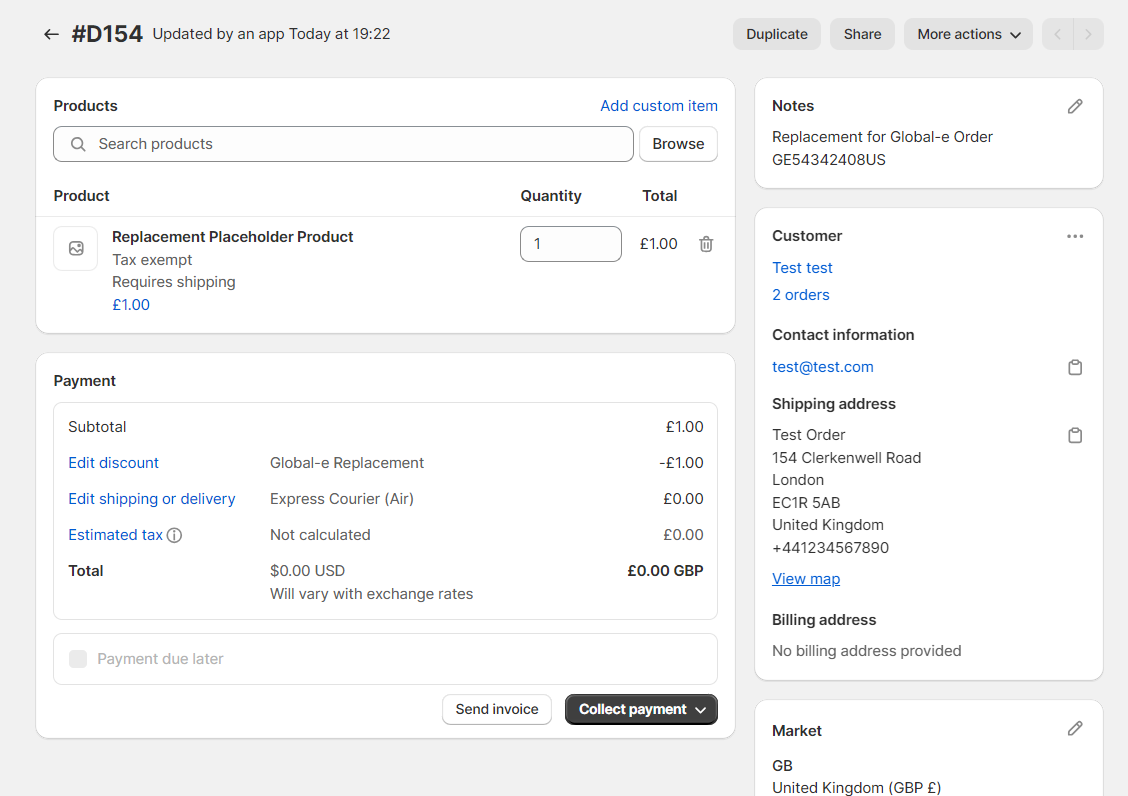
Note
Global‑e uses Shopify’s Draft Order feature to generate replacement orders. As part of the process, a placeholder product with a $0 value is automatically added to the draft order. This product is deleted before the finalization of the replacement order.
Under Products, in the Search bar, type the replacement item's name. - OR -
Click Browse to search through all the products.
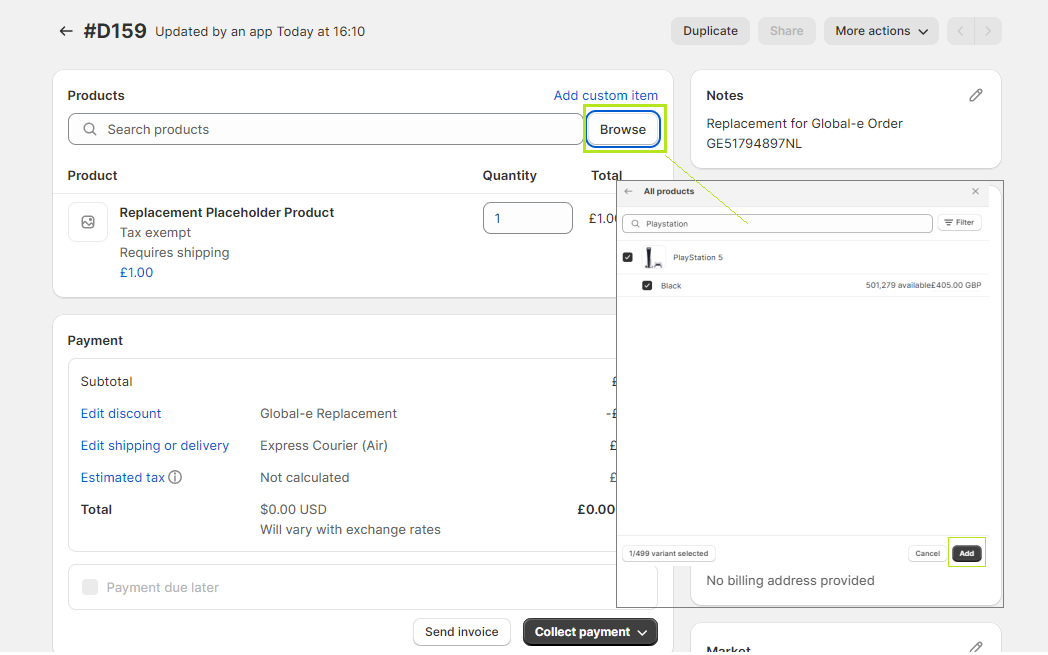
You can use the filter to search for a product by a barcode, SKU, ID, or title.
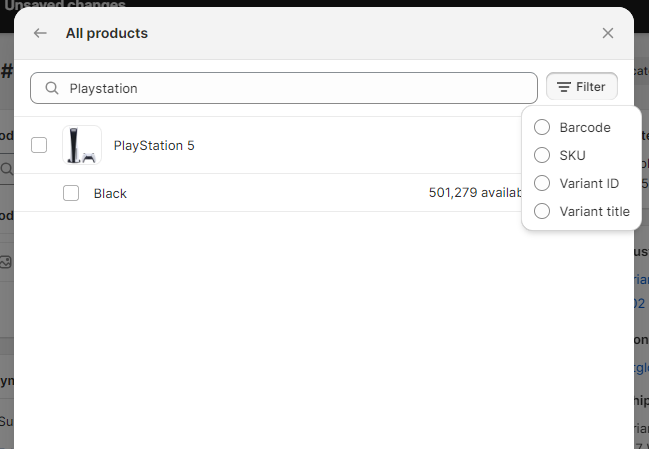
Select one or more replacement products and at the bottom-right click Add.
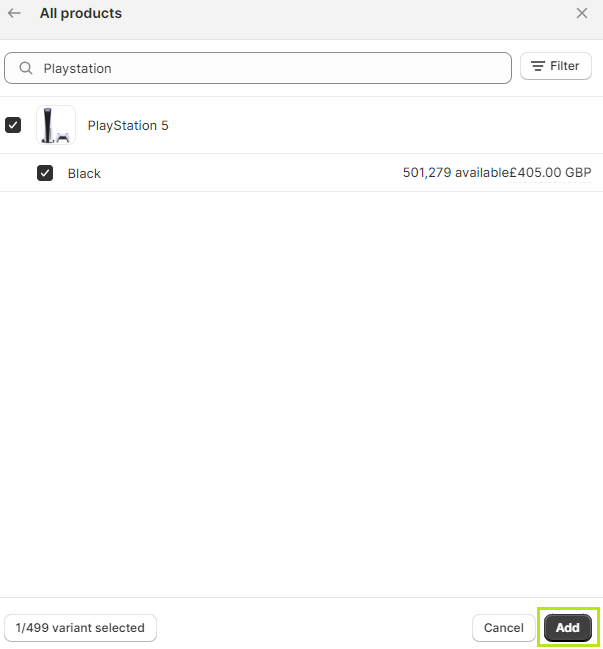
The products are added to the draft order.
The order screen displays:
The placeholder product
The replacement product
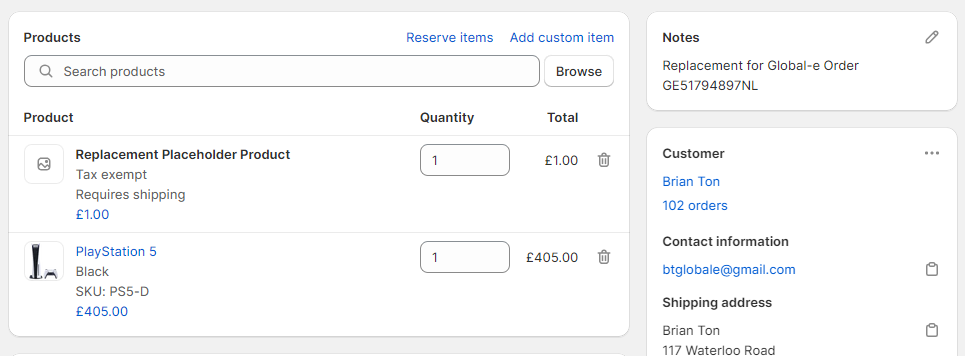
Click the Trash icon to delete the placeholder product.
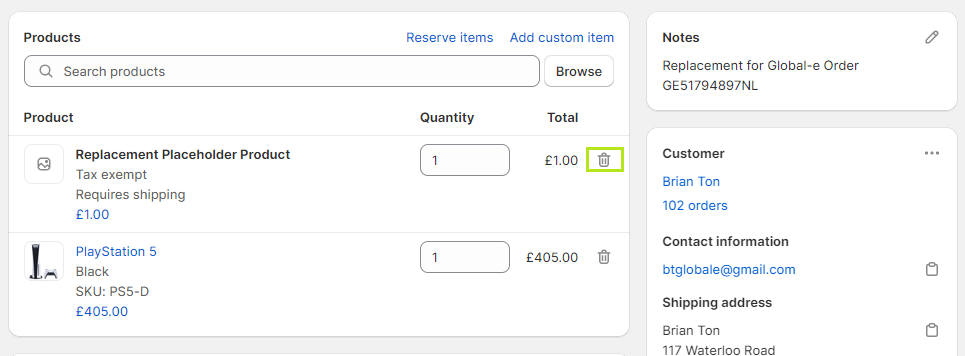
Now, the draft order only includes the replacement product.
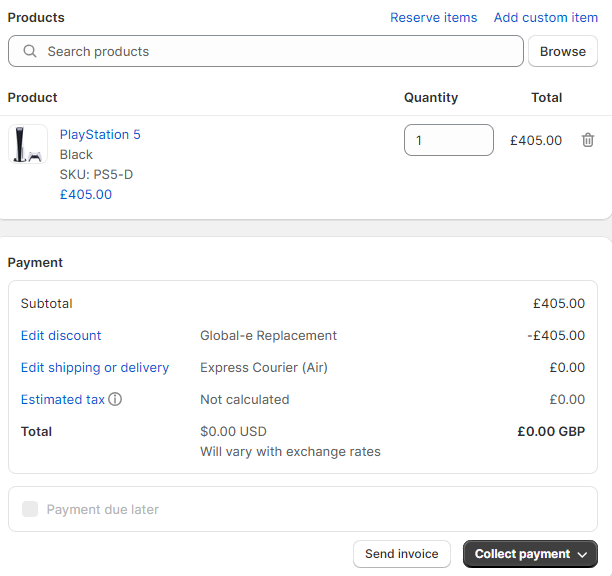
On the right side of the draft order, ensure the customer's shipping address and contact details are correct.

At the bottom of the Payment section, select Collect payment > Mark as paid
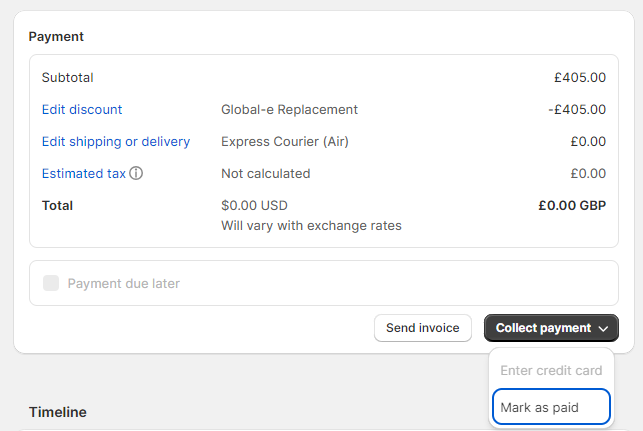
A pop-up appears confirming that an order is created and no payment is required.

Note
The draft order automatically inputs the same shipping method used for the original order and a zero-value shipping fee.
A 100% order discount is automatically applied to the order, bringing the order total to zero. We recommend not changing these settings because it will affect the order's total.
The only time you may need to edit the shipping option is if you use a shipping line Code or Source as an identifier instead of the Title. In this situation, manually edit the shipping information, as detailed below.
To edit the shipping rates:
Click Edit shipping or delivery.
The Shipping and delivery options opens and the ustom rates option is selected by default.
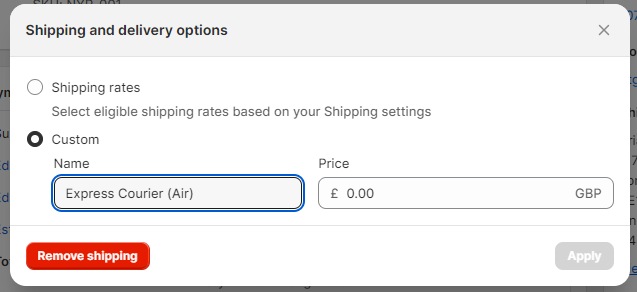
Select Shipping rates.
Choose a shipping method and click Apply.
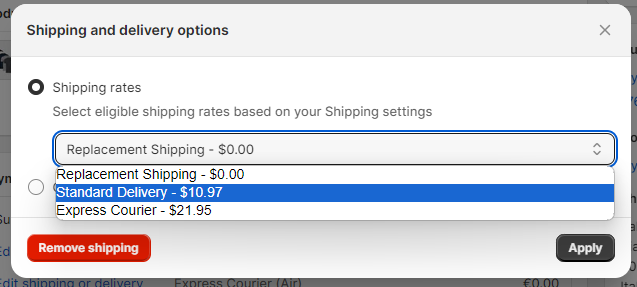
The new shipping rate is added to the order total.
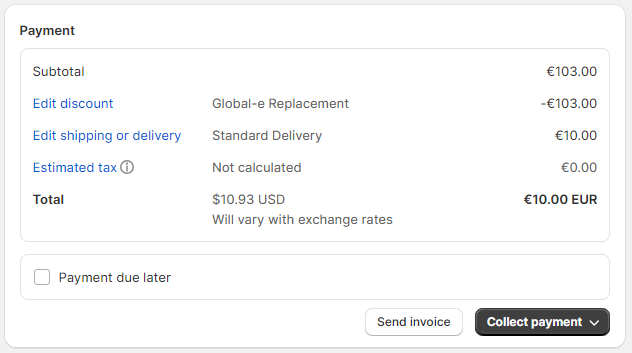
Click Collect payment > Mark as paid.
The Mark as paid window opens.
Input a shipping rate of $1.00 (or more) and click Create order.
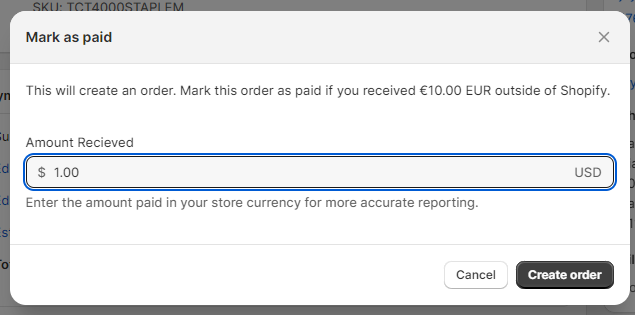
A new order for the replacement item (Replacement order) is created.
In the pop-up, click Create Order.
A new order for the replacement item (Replacement order) is created.
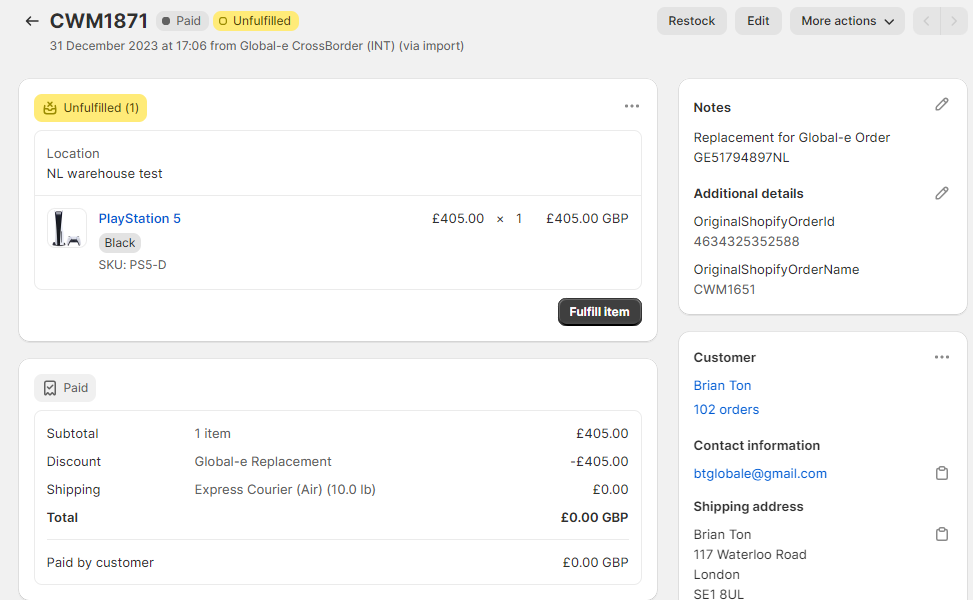
On the Global‑e Merchant Portal, view the Replacement order.
a. From the Global‑e Merchant Portal, go to Orders > View Orders.
b. Open the original order.
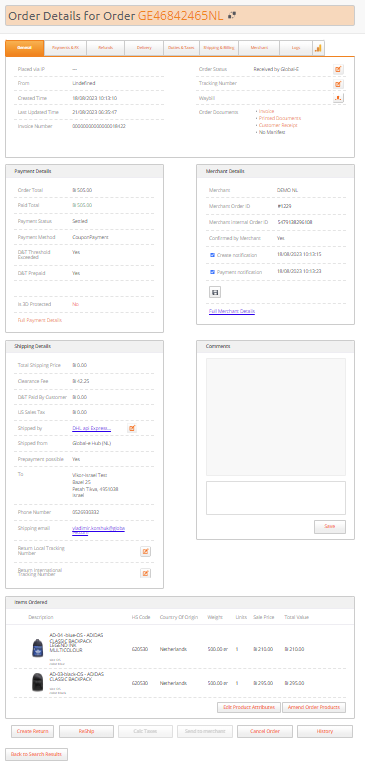
The newly replaced order is added to your ecommerce platform as a new order.
At the top of the order screen, the newly replaced order is flagged as a replacement order.

If you do not wish to include replacement orders in your sales reports, you may need to perform modifications on your ecommerce platform to make sure that they are not included in the sales reports.
Migrating Global-e to Native App
If you are presently running live on the legacy version of Global-e’s Shopify integration, a.k.a the “hosted checkout”, you must migrate to the latest version where Global-e is natively integrated into Shopify’s checkout.
These are the key changes to Shopify order data:
Order transaction is no longer per B2B transaction in a single currency, but per customer B2C transaction instead with presentment currency and shop currency. The B2B VAT is no longer reflected in Shopify.
Order id – Shopify order_name no longer starts with ‘GE’ (e.g, GE2034304US). Orders name is now assigned by Shopify same as for domestic orders (eg., #1234). The Global-e order id is available, see below “From the “Additional Details” section in order data”
Shipping lines/code is now standardized by Shopify as explained in the previous section.
Shipment confirmation emails no longer come from Global-e but instead are managed by Shopify/merchant.
Fraud approval no changes to this flow, still relying on the payment status “pending” (before fraud check) and a subsequent update to “paid” status upon fraud approval with the addition of an order tag “Globale::Approved”
Payment gateway no longer shows ‘globale’, instead:
Global-e Payment (INT) when installing the Global-e payment method in production mode.
Global-e Payments when installing the Global-e payment method in test mode.
From the “Additional Details” section in order data
The Global-e order is still available in Shopify, however not upon initial order creation and only as a note_attribute, which is updated by the Global-e Shopify app a few seconds post-order creation.
Example
"order": {
"id": 4525092405308,
"name": "#1976",
"note_attributes": [
{
"name": "GEOrderId",
"value": "GE10071428326US"
}